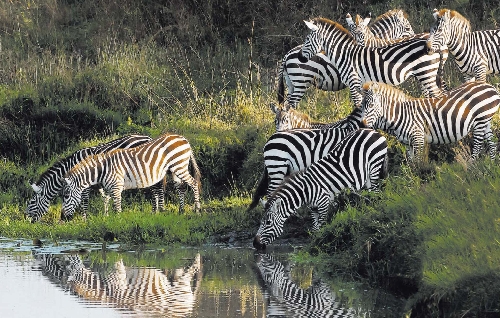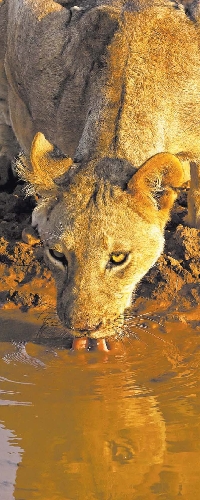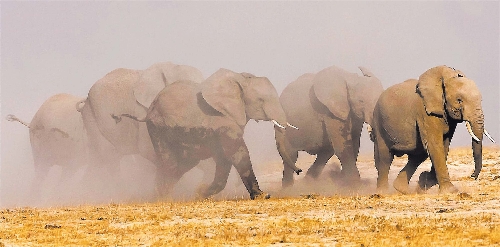ANIMAL PRINTS: Photo safari full of surprises, close-up shots of wild game
The early morning sun bathed the pride in warm light. A halfdozen lions lay on the grassy plain, feeding on a wildebeest, an animal most likely killed by the pride's females the night before. A massive male ripped flesh from the neck of the kill.
Our vehicle was no more than 25 yards from the scene, yet the animals seemed oblivious to our presence. Three photographers snapped dozens of shots of the lions as they fed.
We came away from this wildlife encounter with memorable photographs, as well as the experience of being immersed in the rhythm of nature in Kenya, home to an amazing array of wildlife.
The ability to view animals from such an intimate range was one of the many surprises of this incredible adventure. My friend Bob Karcz and I planned our trip for more than a year before departing Denver in late August. During our two weeks in Kenya, we visited four national parks, observed the life of Kenyans in rural areas and spent a few hours in the capital city of Nairobi.
Kenya is a land of great biodiversity. Habitats vary from rain forest, high moorland, wetlands, semidesert and thorn-bush scrub to grassy savannahs. More than 7,000 species of plants and trees support 25,000 species of animals and more than 1,000 types of birds. The nation is roughly the size of France, with approximately 10 percent of its land set aside as public or private parks and reserves.
Despite growing pressure from a burgeoning human population of around 30 million, animals, even threatened species, are rebounding from years of neglect and poaching. Kenya does not allow hunting.
We got a surprise one morning when our guide learned that a leopard was crossing the savannah of a private reserve adjacent to the Masai Mara National Reserve. He rushed us there, and we followed the animal across the grassy plain for a mile or more, stopping when it was treed by hyenas. (Hyenas will kill a leopard if they outnumber and corner it.)
Once the leopard was able to leave the tree, it passed a small herd of impala. As the cat trotted by, the impala did not run but rather followed and challenged it with a sort of husky bark. We discovered that a number of prey animals behave this way, preferring to keep their enemy in sight instead of run from the threat.
Despite their reputation, lions are not as likely to harm humans as the hippopotamus is. Surprisingly, hippos kill more humans in Kenya each year than any other animal does. They can run as fast as 20 mph despite their considerable girth and stumpy legs.
Hippos protect their hairless skin by spending most of the day submerged in rivers and ponds, going ashore at night to dine on grasses. If alarmed, they will trample anything in their path to bolt for the safety of the water.
The animals are highly social, living in groups of 30 or more. But male hippos are extremely territorial and will fight, often to the death, if another male invades their space.
I had always thought a giraffe is a giraffe is a giraffe. Not so. Kenya boasts three types of the long-necked creatures, each bearing a distinctive pattern of spots on its hide. The reticulated, Masai and Rothschild giraffes are each found in separate parts of Kenya. The three species all share similar traits and habits, though. For example, all male giraffes compete for dominance to win the affection of females by "necking," a fight in which the huge animals whack one another with their long necks.
My main goal for the trip was to come home with at least one good picture of an elephant, my favorite animal. As it turns out, I took several I was proud of.
Kenya is home to about 30,000 elephants, and we were able to observe and photograph pachyderms almost daily.
Once, we saw a group of five elephants, one less than a year old, crossing the Ewaso Nyiro River. The current was so swift that the baby and another youngster lost their footing and tumbled helplessly in the muddy water. Both eventually righted themselves and made it safely across the river. Females keep a close watch on the little ones, who are raised communally.
When elephants flare their huge ears, it is not a sign of imminent attack. Rather, they flap them to cool off. But if an elephant raises its trunk and stamps its feet, that is a good time to start the Land Rover and move on.
A recent article on Kenya wildlife photography says visitors should limit expectations to avoid disappointment. But what I found in Kenya easily surpassed anything I could have imagined.
To gaze across a vast plain dotted with thousands of wildebeest and zebras is an unforgettable experience. Photographing a herd of elephants in total panic stampeding across a dusty plain is a vivid memory. Capturing the image of a lilac-breasted roller perched on a jagged tree branch and seeing female lions caress and groom their cubs are moments that will live with me forever.
Kenya proved to be far more than I expected and provided almost daily surprises.
An old friend who lived in Africa and served in Kenya warned that I would come home with a serious disease called "Africa Fever"--the only cure, a return trip. I'd call the diagnosis spot-on.
IF YOU GO Kenya safari: The key to a successful safari in the African nation is a qualified and experienced outfitter. There are many excellent operators but also a few fly-by-night outfits to be avoided. Plan to spend $2,500 to $10,000 (my trip cost $9,000, which included guides, all in-country transportation, lodging and meals) for a luxurious two-week visit, plus airfare. Our plane tickets cost a little more than $2,000 for coach seats. We flew with United Airlines and Swissair, connecting to Nairobi through Chicago and Zurich. We booked with DK Grand Safaris in Nairobi, a business small enough that we dealt with its owner but a company with the resources to provide a wellplanned and well-equipped expedition. We required specially equipped Land Rovers for our photography needs. Other visitors, in Kenya to view the animals and take snapshots with point-and-shoot cameras, would probably be fine with less expensive vans. Our guides were highly qualified, licensed and quite knowledgeable. Our trip included four national parks/reserves spread across Kenya. We did a fair amount of driving and flying, which took time away from game drives. But for a first-time trip, I would advocate a visit like ours because one learns more about the country and its people by traveling through it. Kenya Ministry of Tourism: www.tourism.go.ke. Precautions: A number of inoculations are required before traveling to Kenya. Also, the U.S. State Department warns visitors to Kenya to be alert for terrorism and violent crime. Recent fighting between Kenyan and Somali rebels has raised the level of concern.






















